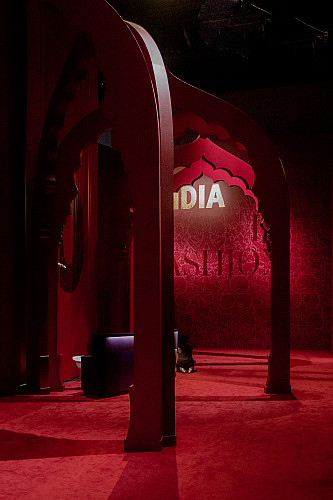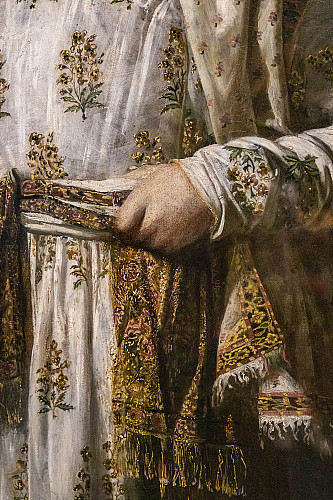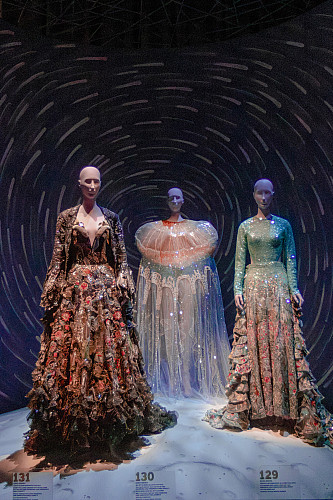Text by Shirin Mehta. With Photography by and Inputs from Asad Sheikh.
1. The entrance to the exhibition featured multiple red arches.
2. The sindoor-red walls of the opening lobby were covered with a scanned brocade weave.
The recently-concluded India in Fashion: The Impact of Indian Dress and Textiles on the Fashionable Imagination, at Mumbai’s spanking new Nita Mukesh Ambani Cultural Centre (NMACC), was a powerful reminder of India’s influence on European fashion. Curated by fashion journalist and editor Hamish Bowles and blueprinted by Patrick Kinmonth, a designer of sets for opera, and Mumbai-based architect Rooshad Shroff, the displays sprawled across a spacious hall and spanned centuries of India’s sway over Western aesthetics. “Beginning in the 17th century and continuing to this day, India’s impact on Western fashion has been a complicated and layered history of admiration, appropriation, exploitation and celebration” writes Bowles in his opening essay to the accompanying book of the same name.
About the design of the space where India in Fashion was housed, Shroff says, “Patrick and I worked together to come up with different scenographies for each of the sections. A lot of them (the backdrops to the exhibits) draw reference from either the time period or a moment of architecture from that particular time period or even a replication of a particular moment in time, like the recreation of the pavilion of the Great Exhibition of 1851 that was held at Hyde Park in London during the time of Queen Victoria.”
And interestingly Deepthi Sasidharan, art historian, heritage consultant and founder-director of Eka Archiving Services, who conducted a walk-through with the Verve team, points out, “There are two parallel storylines. One, the story of fashion. And the other is, of course, his (Kinmonth’s) referencing of India.”
The exhibition was presented against a backdrop inspired by Indian motifs, stylised arches and an opening lobby styled predominantly in sindoor-red, with walls embellished with a scanned brocade weave of a royal hunt in a procession filled with all the classics of the Western imagination of princely India — tigers, deer, and riders. Some might have regretted the approach being through a somewhat anglophile lens. But whatever the slant might have been, we need not lose sight of the importance of an exhibition such as this: a fitting documentation of the principal milestones of Indian influence on fashion which, in a sense, set the record straight — and about time too.
1. Armadillo boots, famously seen in Lady Gaga’s Bad Romance music video, were part of the late Alexander McQueen’s final collection, Plato’s Atlantis.
2. A framed photograph of a blue-green elytra beetle, used in the Deccan beetle wing embroidery and said to be the inspiration for the late Alexander McQueen’s final collection, hung on the wall behind the Armadillo boots.
The 10 sections aimed at inserting India’s presence in global design through different lenses that ranged from inspiration to innovation. The primary section basically looked at various flashpoints of inspiration. “The influence of India’s culture of dress and its superb craft traditions has been exerted beyond its frontiers for more than a thousand years,” states the exhibition brochure. Yet the first garment you encountered seemed somewhat perplexing in that it seemed to be an outlier with no apparent connect to the country. Jellyfish, the outfit from the late Alexander McQueen’s final collection, Plato’s Atlantis, consists of dress, leggings and Armadillo boots (made famous by Lady Gaga) embroidered with iridescent enamel paillettes. A link to India is however established in the caption of a framed picture of a blue-green beetle on the wall behind. It points out the Deccan beetle wing embroidery, practised in India, as the scaly inspiration for the textile used by McQueen for his garment.
“Beetle wing embroidery was much sought-after in the 18th and 19th centuries. It spread across the world, especially England, where it was considered as the epitome of luxurious clothing. And McQueen was actually inspired by it,” asserts Sasidharan, silencing sceptics. However, being able to showcase such a rare object of fashion history here almost seemed like reason enough for its presence which highlighted the state-of-the-art preservation system that now allows us to see a garment in Mumbai instead of having to travel to museums around the world.
Court suits made using silk brocade, zardozi, glass beads and tinsel, circa 1830. On loan from the Royal Ontario Museum, Toronto.
Besides the McQueen ensemble, these first six rooms included two boys’ court suits from the 1830s made of brocade and embellished with zardozi embroidery, and a Federico Forquet dhoti-inspired jumpsuit of printed silk from 1967. Of interest were a silk lamé organza drape dress from the Autumn/Winter 1956 collection by Dior, paired with a distinctive Tarun Tahiliani draped creation in crinkle tulle from 2020. Both use sari drapes as an inspiration point, more than six decades apart.
Two dresses — by Christian Dior, 1956 (left) and Tarun Tahiliani, 2020 (right) — underline the versatility of the sari drape.
It was in this space that we discovered what Sasidharan conjectures is one of the oldest garments presented here — Captain John Foote’s jama (robe). “The jama has been such an inspiration and it was later taken on as a women’s silhouette as well,” the heritage consultant says. From 1750 and made of the finest muslin with block printing and embroidery, the garment has been presented together with a portrait of the man wearing it, thus throwing into focus that British men did embrace Indian textiles and, at times, the silhouettes as well. “This fact wasn’t publicised as much because it wasn’t much of a colonial narrative to put out there,” adds Sasidharan. “But the fact is that almost all British gentlemen who lived and worked here, had to adapt to the heat.”
1. A mannequin is dressed in Captain John Foote’s jama (robe), patka (a small shawl used as a sash around the waist) and shawl, as seen in the painting.
2. Captain John Foote’s ensemble, painted between 1761 and 1765 by Sir Joshua Reynolds in London.
Following a small section with a fleeting homage to Bollywood that seemed inevitable, two segments, “Gathered in a Mughal Garden” and “The Long Shadow of Muslin”, centred around the Coromandel coast’s chintz kalamkaris and Bengali muslins, respectively. These sections worked in tandem to bring to life the early colonial imagination of India. “The vast textile business contributed to making the Mughal Emperor…the richest monarch in the world.’ And presented a prize that the rapacious East India Company was keen to seize” Bowles writes. The exhibition brochure states that the popularity of the fabric in the 18th century led to a ban on its import from India “and that subsequent commercial exploitation of imitations sold back to India only provoked a greater passion for the originals”. Shroff expounds, “There is a lot of history intertwined with politics and the idea of how fabrics and garments were playing into a larger conversation and creating an impact on society.”
The chintz room, with water ripples printed on the carpet and a sound projection that enhanced the feeling of walking in a garden, featured multiple pieces loaned by The Art and People of India (TAPI) Collection as well as a quilted “banyan” coat worn by George IV when he was the Prince of Wales. “It’s quintessentially an Indian silhouette for an Indian man. But this was worn by British men,” Sasidharan enlightens. Eight garments including dresses with hooped skirts, circled a Rahul Mishra creation, where the embroidery has been inspired by chintz. An interesting fact is that the exhibition featured commissioned works by some designers, interpreting vintage styles in a modern context; this included the Tahiliani drape mentioned earlier as well as the Mishra conception.
Balloon sleeve details of a woollen dress with an embroidered chintz pattern, commissioned to Rahul Mishra. An embroidered chintz Palampore from the TAPI Collection can be seen behind.
“I love the whole cycle of different techniques that chintz as a fabric has gone through. From being painted and hand printed using natural dyes to being mass produced using mechanised printing. It was interesting to see the whole journey of chintz come alive; with the Palampore textiles from the TAPI Collection, to the European dresses to the recent commission of the embroidered chintz gown by Rahul Mishra,” says textile revivalist and curator Lavina Baldota.
The segment on Indian muslin, presented in a circular room under a giant parasol, underlined its popularity during the Regency period. The fabric, though associated with “humble usage” as related in the brochure, “made its way into the fashionable milieu in the early 19th century. Sometimes embroidered, sometimes plain, it brought an Indian summer to the West”. Much of the Jane Austen classics we grew up reading had women strolling in gardens with cream-coloured parasols featuring this fabric. Four classic empire-line dresses were paired with an Abu Jani and Sandeep Khosla chikankari embroidered dress from 1993 and a Raw Mango mulmul sari from 2017.
The “Long Shadow of Muslin” section featured a cotton muslin sari by Raw Mango; here it is juxtaposed with an empire-line cotton muslin European gown from the early 19th century.
In “India’s Allure Meets Paris Couture”, in the next three sections, we encountered a remarkable array of garments from French couture houses Chanel, Christian Dior and Yves Saint Laurent — which revealed the essence of India. Chanel, the quintessential French label, came first with an impressive collection starring pieces from Gabrielle Chanel herself, a rare treat for fashion lovers in India. At Dior, what occupied pride of place was the iconic Lahore dress made by Christian Dior himself and a more structured dress in Marc Bohan’s characteristic rigid simplicity titled Koh-I-Noor followed by an embroidered waistcoat and trousers by Maria Grazia Chiuri, the house’s current creative director for women’s lines. Further, former creative directors, John Galliano and Gianfranco Ferré, were aptly represented.
1. An Yves Saint Laurent ensemble that explores Indian bejewelled motifs and the Nehru collar through a silk shantung evening suit, circa 1982.
2. Yves Saint Laurent’s 1982 Summer couture collection was inspired by the grand Mughal style; the set design of the section dedicated to him, was inspired by Indian stepwells.
But it was the last of the French trio, Saint Laurent, who had the most striking set. The room featured gridded walls in copper-hued metal that reached up to the ceiling of the exhibit hall, with the pieces displayed in alcoves on the walls. The design was inspired by the stepwells of India. “This was actually one of the most technically challenging spaces to create because every single rod was hand-soldered and welded together to form the space,” Shroff muses. “We wanted to create a very light, almost see-through feel so that you do not have the solidness of the stepwell yet you have its overall silhouette so that the clothes stand out.” At the centre of the room was a couture creation from 1982, where the late designer sought inspiration from European sketches of Mughal costumes, resulting in turbanned looks with bolero jackets and large skirts in silk faille and silk moiré.
Architectural details between two sections of the India in Fashion exhibition — “Yves Saint Laurent” and “Journey of the Sari”.
Ahead of the clothes room, a short corridor lined with tables with sketches by Saint Laurent himself, featured the designs displayed in the previous room. The dim corridor was illuminated by a bright light at the end where Isha Ambani Piramal’s Valentino wedding lehnga, a stunning piece in guipure lace with gold foil work that imitates the texture of zari embroidery, was displayed in the next section, titled “Valentino — Marriage of East and West”.
Time now to pay homage to that iconic garment, the sari, in a section all on its own. The sari, styled as a dress, by Mainbocher was sourced from the MET (Metropolitan Museum of Art), New York. Stylised drapes inspired by the sari could be seen in a Givenchy dress and two pieces by Cristóbal Balenciaga. A pallu (the loose end of a sari) thrown over the upper body at a 45-degree angle was the basis for much of Madame Grès’ works. A dress by Paul Poiret (featuring a skirt in sari fabric from 1922), a pleated sari-inspired dress by Elsa Schiaparelli from 1939 and an actual sari commissioned to Christian Dior in 1953 by an anonymous client, were on display.
1. The opening piece for the section, “Journey of the Sari”, was a sari dress in metallic jersey fabric material by Tarun Tahiliani.
2. Elsa Schiaparelli’s interpretation of the sari through a dress that dates back to 1939. It is said to be inspired by her encounter with Princess Sita Devi of Kapurthala on her visit to Paris in 1935.
The exhibition space then opened out into a large hall modelled after the Great Exhibition of 1851 which had showcased goods from across the world. The set design had been amazingly recreated from the original exhibition, right down to the flat lays, the standing exhibits, and, of course, the arched glass ceiling (the original building had been referred to as Shalimar). “In a typical museum, you are dictated by room sizes and the architecture,” says Shroff. “This particular case was different because we were working in a convention centre geared towards museum specifications…. We had 50,000 square feet to work with….” A variety of intricate Kashmiri weaves, experimental footwear by Christian Louboutin, revival crafts by Ritu Kumar and a dress by Charles Frederick Worth were showcased against an intricately hand-embroidered backdrop of a banyan tree, which took about 80 kaarigars (artisans) over a month to create.
1. A Rudi Gernreich dress, inspired by the hippie movement in the ’60s, utilised the Rajasthani bandhani tie-dye textile.
2. The “Hippie Trail” section was composed of a circular set of red mannequins, dressed by Western designers who have based their work on the imaginative freedom and mysticism that India symbolised.
3. Resembling the curved drape of the dhoti, this Madame Grès jumpsuit in silk taffeta — on loan from the Costume Institute at the MET — highlighted the designer’s modern interpretations of India.
4. The second section of the “Hippie Trail” featured six pieces from Manish Arora, John Galliano and Dries Van Noten. Here, a sari-dress (right) from Galliano’s 2002 Holi-inspired collection is placed next to a cape dress by Arora (left).
The two parts of the “Hippie Trail” transported us to the tumultuous era of the ’60s with Zandra Rhodes, Rudi Gernreich and Thea Porter pieces, all imagined in an idea of Rajasthan, the nomadic spiritual vision of India during that time. The setting of the second part was inspired by the Jantar Mantar observatory, with six garments perched above the ground in circular boxes. Two of Galliano’s wildest looks from the 2002 Holi-inspired collection were present, along with two silk ikat dresses by Dries Van Noten and a cape dress by Manish Malhotra. Shroff credits inspiration for the backdrop to a time when the West “fed up post-war, flocked to India and particularly to locations like Jantar Mantar in search of an alternate reality”.
Appropriately, India in Fashion concluded with a showcase of current Indian designers. After all, “The end point of the exhibition is that Indian fashion has arrived, or at least that’s the messaging,” Sasidharan said. A tableau with Sabyasachi’s bridal wear, pieces by Abu Jani and Sandeep Khosla, Manish Malhotra, a display with Rahul Mishra’s space-inspired garments, represented the classics of mainstream Indian high fashion.
1. The opening showcase for the final section of the exhibition presented Sabyasachi Mukherjee’s white bridal wear.
2. The closing display of the exhibition featured three space-inspired ensembles with hand embroideries, by Rahul Mishra.
The exhibition enthralled with its sets and the delight of viewing garments never before been able to be seen in the country. For the first time, a gamut of institutions and archives from around the world loaned collections, ranging from the Royal Ontario Museum to the MET. “You break it down…there’s a cultural layer, there’s an economics layer — there’s accessories, costumes, there are world events that were happening…. I’m familiar with a lot of the milestones that were presented in this exhibition, and it is the convergence of over 250 years of history and politics and really a view of the world scape through fashion….” Sasidharan concludes.


















